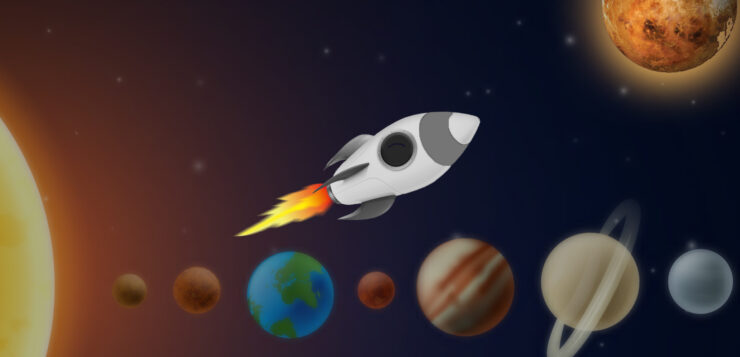It’s unlikely that our current Solar System will be our home forever. In fact, it’s impossible. With an expiration date on both Earth and the Sun, it’s practically unarguable that humans will eventually have to leave the Solar System to survive. While currently, the idea of interstellar travel seems more in line with science-fiction than science-fact, it’s unreasonable to think that this will always be the case.
Our closest neighbouring star is Proxima Centauri, sitting 4.246 light-years away with an exo-planet named ‘planet b’, also referred to as ‘Proxima Centauri b’, which theoretically may contain liquid water. With the possibility of the presence of water, we can deduce that the planet sits at a temperature that can sustain human life as well assuming the planet has oxygen (water is after all a mixture of hydrogen and oxygen). Yet that 4.246 lightyears is a daunting number, one which at the current would take humans over a thousand years to reach. So in order to leave our Solar System, we need to find a way to travel through space at rapid speeds.
In Einstein’s theory of relativity, one of the arguments stated is that nothing can surpass the speed of light (299,792 km/s). In the simplest of terms, Einstein and other scientists believe this because light is basically massless (modelled as a wave) which means it doesn’t lose energy like particles do through friction, sound, heat, etc. It’s unlikely then that a human-made object comprised of massive particles could travel faster through a vacuum when battling all these energy losses. Our fastest human-made probe reached speeds 0f 532,000 km/h (147.7 km/s) translating to around 0.05% of light-speed. At that pace, we’re not going to be getting anywhere quickly and so developments in science and technology need to come a lot further to allow humans to reasonably leave our Solar System.
In 1977, Nasa launched Voyager 1 into space where it has since managed to leave the Solar System, currently estimated at 18.5 billion kilometres away from Earth. Yet Voyager 1 would approximately take over 40,000 years to reach our closest star at its current speed of 45 km/s. So everything points to us being too slow to make it to Proxima Centauri.
So we have three options. One: develop spacecraft that travel meaningfully quicker through space to make the journey time more manageable. This requires us to make dramatic leaps in scientific development which, while not impossible, is not a solution with a quick turnaround. Even if we manage to develop spacecraft that can travel at 1% the speed of the light (20 times faster than we have currently reached), it would still take hundreds of years to reach Proxima Centauri b, which we can’t even be sure could support human life, with only an educated deduction (a fancier way of saying ‘guess’, to be frank) of its viability.
Option two requires advancements in cryogenics, finding means by which we can preserve humans for prolonged periods of time. Our study of animals during hibernation, alongside theories on cryogenic freezing (films often referring to this process as ‘hypersleep’) indicate that it could be possible to induce humans into an extended sleep/frozen period during which the passing of time would feel indistinguishable. Our problem isn’t necessarily the cryogenics side though, but in how we ‘wake up’ those in hypersleep and whether it is even possible. Again, it’s something for which science hasn’t come far enough to give definitive answers, with little to indicate any breakthroughs in this field coming over the horizon.
Finally, our third option is to turn away from travelling on spacecrafts to find habitable exoplanets and instead look towards the vastness of space as our solution (not unlike the positions the humans find themselves in in Pixar’s Wall-E). It might be theoretically easier to create spacecraft that are designed to support human life in space for prolonged periods. This way speed becomes much less of a factor, with the problem now being how to survive in space. We might have more success in designing spacecraft for prolonged habitation rather than for the fastest interstellar travel possible. Inevitably there would be problems with finding a renewable energy source (solar cells are great but require us always to be near a star) as well as with establishing a constant supply of food, water and oxygen and with overcoming the long-term effects space habitation has on humans. Excursions to planets or other space-based reserves of essential resources would become necessary to support human life, but could also pose great risks
Although all three options aren’t currently feasible, option three might be our best solution and the easiest to plan towards. Either way, it’s difficult to fathom that we could evacuate the entirety of all humans from Earth, especially as our population grows exponentially. We can however plan for smaller scale expeditions to ensure the survival of the human race, as long as our extinction doesn’t come before our technology advances enough to enable them!
So, is leaving our Solar System possible? Theoretically, yes. Once we consider the inevitable death of our solar system, albeit with a sizeable preparation period, it will in fact become a necessity to do so, rather than an ‘if’. However, whether we have enough time and resources to make these preparations will always be a problem – one that, rather ironically, only time will be able to tell.




